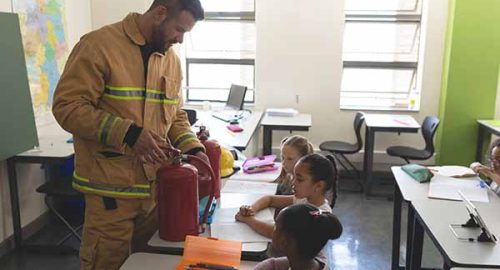School safety drills play an essential role in developing the skills that students and staff need to protect themselves during an emergency.
The more schools conduct well-planned safety drills, the more intuitive the processes will become for participants and the more successful your schools emergency response will be.
Below is an overview of nine school safety drills and exercises recommended by the National Association of School Psychologists, the National Association of School Resource Officers, and Safe and Sound Schools in their latest report, Armed Assailant Drills In Schools. The types of safety drills and exercises progress from simple to more complex tasks.
1. Introductions
Students and staff should be given a quick review of their schools processes for managing crises. These reviews involve teaching the community about the crisis management professionals who will partner with the school and aid in the event of an emergency. A description of their appearance, their duties, and the tools they use to perform them would all be useful information to provide during these reviews.
2. Orientations
Orientations involve a more in-depth review of a schools crisis management processes and give students, staff, and first responders the opportunity to familiarize themselves with the layout of the campus, including areas that aren’t usually accessible unless there is an emergency. That way they’ll be prepared and know where to go in the event of an evacuation or shelter in place.
3. Seminars/Workshops
Utilizing instructional media is a great way to teach students and staff how to effectively respond to emergencies. Examples of instructional media include videos, books, and songs that contain messages about what to do in an emergency. When creating these materials, it’s important to take into consideration the appropriateness and relevance of the content presented. This can be done by reviewing the content to ensure that it is age appropriate and doesn’t contain material that may be considered too graphic for its intended audience. Schools should also allow parents to withdraw their children from any lessons they deem inappropriate.
4. Tabletops
Tabletops allow small groups to assign each of its members distinct roles in safety scenarios, so they can communicate their ideas and develop solutions to later share with a larger group. These exercises can be altered to cater to different age groups and can include first responders and law enforcement.
5. Walk-Through Safety Drills
Walk-through safety drills are slowed down drills that allow students to practice how they would respond to an emergency. They provide a great opportunity for students to ask questions that they wouldn’t be able to ask during faster-paced drills. They also allow different teams to develop a better understanding of each other’s roles. These safety drills can also test the effectiveness of your emergency response protocols and systems.
6. Preannounced Safety Drills
As the name would imply, preannounced safety drills are discussed beforehand, so participants know that the drill is scheduled and there is no real emergency. Participants practice their responses and undergo the same protocols that they would in case of a real emergency.
7. Unannounced Safety Drills
Unannounced safety drills are not discussed with all participants before. However, once the drill is initiated, participants are immediately told it is just a drill and not a real emergency. Unannounced safety drills allow participants to practice their responses and go through protocols as if there were in a real emergency. For these reasons, it’s important to mention that schools that’ve undergone traumatic events in the past should practice preannounced safety drills instead, to avoid triggering traumatic memories in participants.
8. Simulation Safety Drills
Simulation safety drills involve modifying the environment to resemble different emergency scenarios. This makes them ideal for emergency responders, as they will likely be put in similar conditions if they respond to an incident at the school. Due to the graphic nature of the scenarios presented, these kinds of drills should be conducted in a professional manner to avoid causing participants mental or physical harm. Simulation safety drills should not be required for students and staff, and whenever they are conducted, participants must be made aware of the fact that they’re about to perform a safety drill.
9. Full-Scale (Advanced) Simulation Exercises
These exercises require the collaboration of schools with emergency response teams. Multiple different emergency scenarios are typically presented to participants. Given their complexity, they are expensive and can take up to several months to coordinate. Additionally, students and staff who wish to participate in these exercises must undergo mental health screening to ensure their own safety and well-being.
Practice Safety Drills and Be Prepared for Emergencies with Raptor
As schools return to in-person learning, they must reevaluate their safety procedures and be prepared for emergencies. The more your school community is trained to respond, the more successful your emergency response will be. This all hinges on how well you conduct and learn from your safety drills.
Raptor Emergency Management, an allowable expense under all ESSER funding, includes Raptor Drill Manager. With Raptor, you can schedule drills and track compliance; receive automatic notifications before upcoming drills; quickly verify each buildings drill activity, and analyze reports to see what is working and where you need to improve performance.






